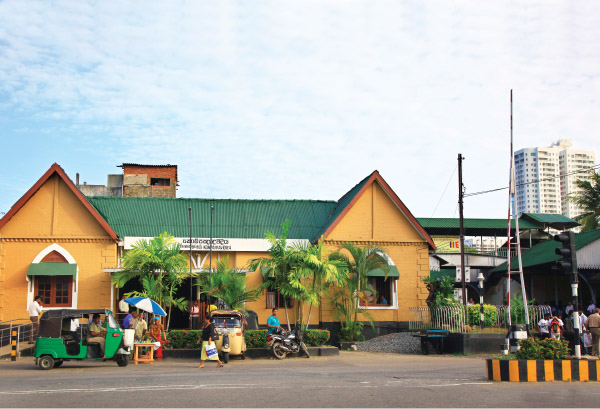
I might have travelled on Union Place and passed Slave Island an umpteenth time when travelling around Colombo. I might have asked for directions to get by in Colombo 2 and gotten Kompannya Veediya Railway station, Kew Road, or the Nippon Hotel as landmarks. But when I sat down to think of what I knew, experienced and felt about the locale, it would still sift down to the loud, busy area bustling with commercial commotion in the day and the hybrid night-out facilitated by the friendly vendors along the way.
Words Miuru Jayaweera Photographs Indika De Silva
Slave Island poses to me a sepia landscape – of a shady eventful past with multiple stories narrating the background of each building, by-lane and the three colonial eras of Sri Lanka – that could put a saga to shame.
Located directly to the South of the Colombo Fort area, Slave Island’s chronicle begins in the 1700s when the officers of the Dutch East India Company placed their slaves to cook and clean their mansions built on the then picturesque islet or the ‘Slave Island’ of the now Beira Lake. These slaves brought down originally from Africa by the Portuguese in the 17th Century were called the Kaffirs. It is believed that a dwindling number of descendants of this almost extinct race are settled in the North West of Sri Lanka at present. Much has been written and investigated about them and it is evident that the positive coexistence through generations has led the Kaffirs to embrace and welcome not only the local culture and customs but also languages and religions.
Today the area is a mix of ethnicities from the Malays to Moors, Christians, Buddhists and the Hindus…
Rewind back to 1845. The British invades Ceylon and subsequently abolishes slavery. However, Slave Island retains its name to date, maybe to connote and preserve the not so unforgettable past.
I sat down in a small eatery; one in the sprawling line of a shopping and commercial precinct on Justice Akbar Mawatha known as the oldest building in the area built by the Dutch.
While making small talk with the owner of the eatery cum mini recreation shop I learnt that I was sitting at the enclosure called the Cave Building named later after the Brit, Henry W Cave, who converted it into a commercial store some hundreds of years ago. “Back in the day, my grandfather told me stories of dried coffee beans in their millions buried in the soil here,” my new found friend pointed to what would’ve been a backyard used for drying coffee by the British owners of the building, which now is the rear extension to his house.
Slave Island is also believed to be the first Malay settlement in Sri Lanka; drawing evidence from the famous streets in the area named after them, The Malay Street and Java Lane. The Malay Military Mosque at the turn around to Java Lane speaks of a colourful story where the Dutch were said to have brought in a contingent of Eastern Soldiers from Java and settled them around the area. This contingent of Javanese soldiers who also fought for the British colonial rulers later had taken a liking to the natives so much that they had made Slave Island their home.
Today the area is a mix of ethnicities from the Malays to Moors, Christians, Buddhists and the Hindus with the conspicuous semantics of the Seema Malakaya of the Gangaramaya temple, kovils, churches, and mosques playing symbolism complemented with the cacophony of Sinhala, Tamil and English languages ringing in the ears of anyone walking past Slave Island.
‘Slave Island’ to the Portuguese, the Dutch and the English, and also refered to in English in the present day but what’s the story behind the Sinhala name given to the area ‘Kompannya Veediya’? Something about the way the Sinhala version was pronounced made me re-read the lines I so enjoyed in Carl Muller’s ‘The Jam Fruit Tree’. In this story about the Burgher population of Sri Lanka, Muller exacts how the Von Blosses, (the protagonists of the semi-autobiography) planned ahead for a wedding in the family to purchase ice and beef from Elephant House in Slave Island. ‘The Jam Fruit Tree’ is set in the 1900s. The Elephant House at the time was the Colombo Ice Company I learnt, crediting itself for owning the country’s first ice making machine. Ice had been such a luxury that natives had to book their quota well in advance and that the area had been named after the ‘Company’ itself and later as Company Street or Company Veediya, hence Kompannya Veediya in the present day.
What’s the story behind the area ‘Kompannya Veediya’? It had been named after the ‘Company’ itself and later as Company Street or Company veediya, hence Kompannya Veediya
Today, a busy commercial quarter with government and corporate offices, a road named after and affiliated in the past to London’s Kew gardens, shops, an antique railway station, supermarkets, hospitals, restaurants and houses with rows of coexisting ethnicities, Slave Island and its stories of a bygone era is undoubtedly a writer’s remarkable experience.
[nggallery id=360]


